Information and Digital Technology: Theories, Systems, Globalization, and Digital Infrastructure
VerifiedAdded on 2023/06/08
|9
|2153
|307
AI Summary
This report covers the theories, methods, and techniques related to the design and development of McAfee and MS Office. It also describes different IT systems and their examples, the impact of IT on globalization, and the advantages and disadvantages of digital infrastructure.
Contribute Materials
Your contribution can guide someone’s learning journey. Share your
documents today.
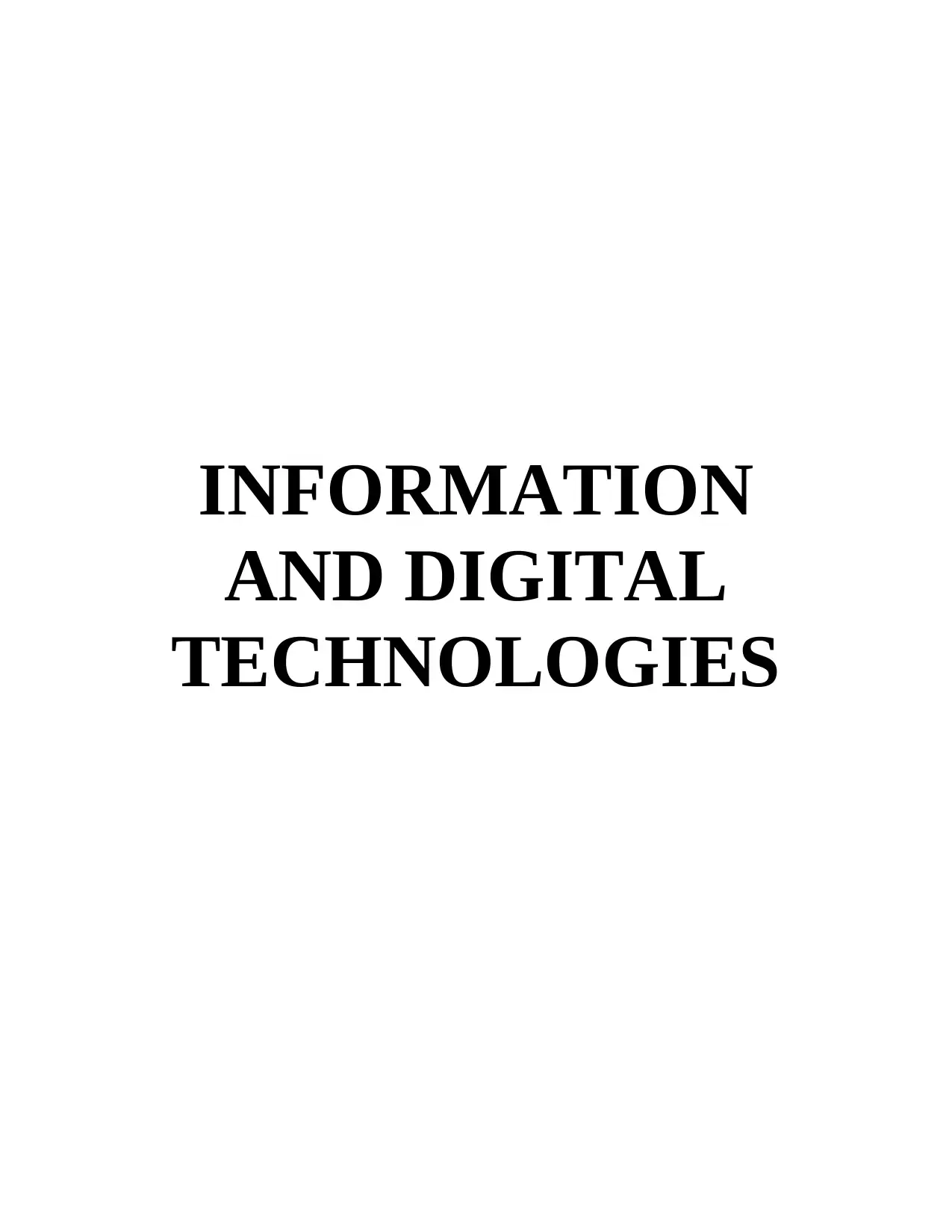
INFORMATION
AND DIGITAL
TECHNOLOGIES
AND DIGITAL
TECHNOLOGIES
Secure Best Marks with AI Grader
Need help grading? Try our AI Grader for instant feedback on your assignments.

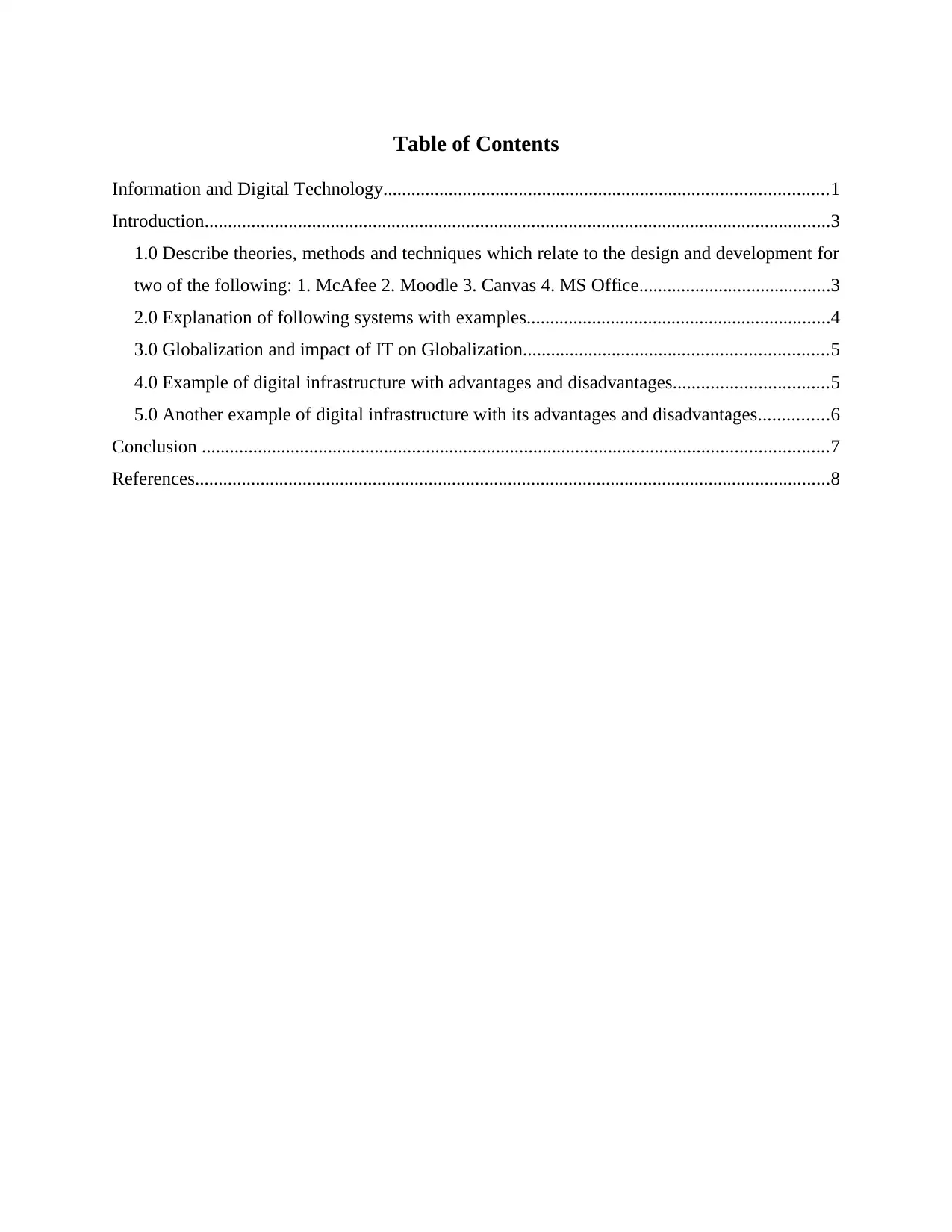
Table of Contents
Information and Digital Technology...............................................................................................1
Introduction......................................................................................................................................3
1.0 Describe theories, methods and techniques which relate to the design and development for
two of the following: 1. McAfee 2. Moodle 3. Canvas 4. MS Office.........................................3
2.0 Explanation of following systems with examples.................................................................4
3.0 Globalization and impact of IT on Globalization.................................................................5
4.0 Example of digital infrastructure with advantages and disadvantages.................................5
5.0 Another example of digital infrastructure with its advantages and disadvantages...............6
Conclusion ......................................................................................................................................7
References........................................................................................................................................8
Information and Digital Technology...............................................................................................1
Introduction......................................................................................................................................3
1.0 Describe theories, methods and techniques which relate to the design and development for
two of the following: 1. McAfee 2. Moodle 3. Canvas 4. MS Office.........................................3
2.0 Explanation of following systems with examples.................................................................4
3.0 Globalization and impact of IT on Globalization.................................................................5
4.0 Example of digital infrastructure with advantages and disadvantages.................................5
5.0 Another example of digital infrastructure with its advantages and disadvantages...............6
Conclusion ......................................................................................................................................7
References........................................................................................................................................8
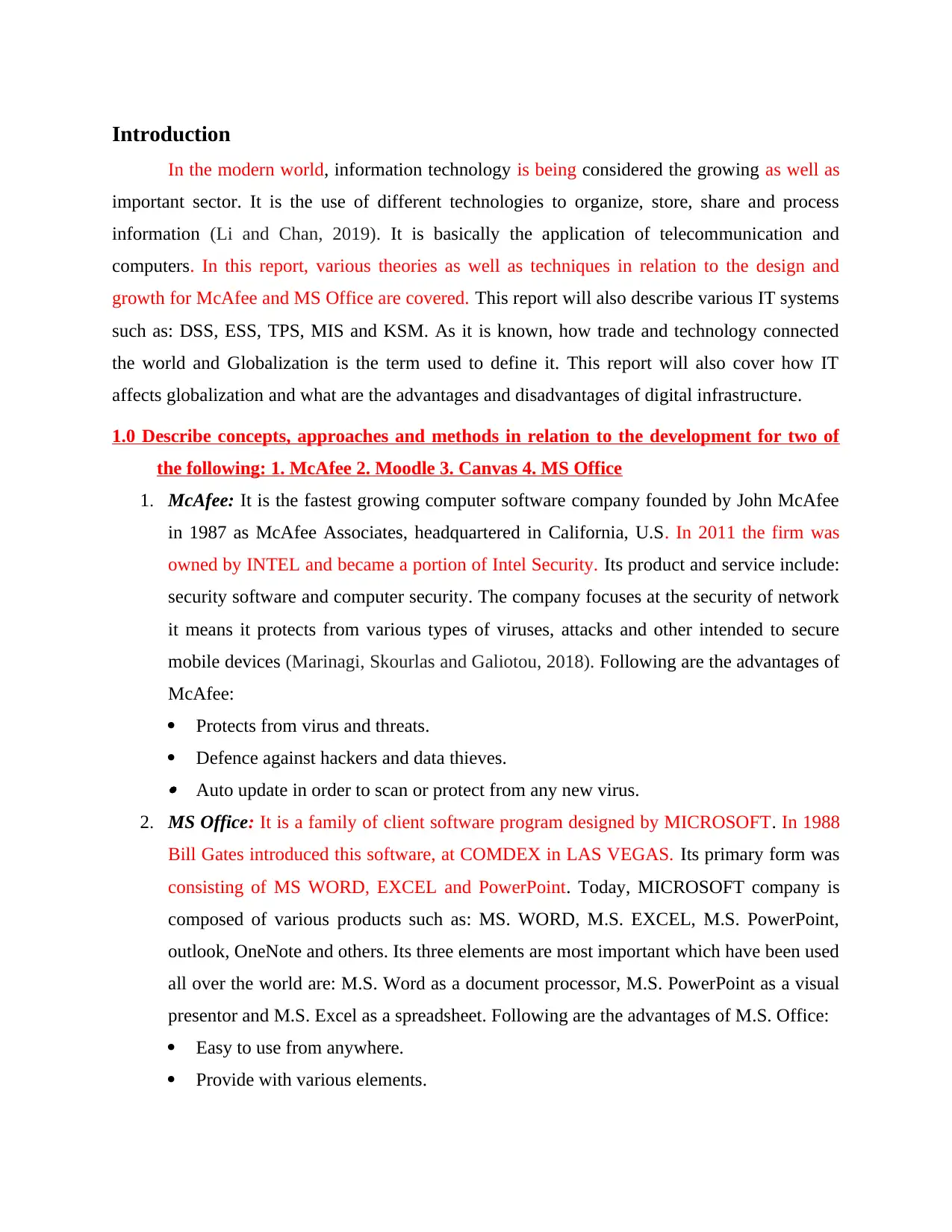
Introduction
In the modern world, information technology is being considered the growing as well as
important sector. It is the use of different technologies to organize, store, share and process
information (Li and Chan, 2019). It is basically the application of telecommunication and
computers. In this report, various theories as well as techniques in relation to the design and
growth for McAfee and MS Office are covered. This report will also describe various IT systems
such as: DSS, ESS, TPS, MIS and KSM. As it is known, how trade and technology connected
the world and Globalization is the term used to define it. This report will also cover how IT
affects globalization and what are the advantages and disadvantages of digital infrastructure.
1.0 Describe concepts, approaches and methods in relation to the development for two of
the following: 1. McAfee 2. Moodle 3. Canvas 4. MS Office
1. McAfee: It is the fastest growing computer software company founded by John McAfee
in 1987 as McAfee Associates, headquartered in California, U.S. In 2011 the firm was
owned by INTEL and became a portion of Intel Security. Its product and service include:
security software and computer security. The company focuses at the security of network
it means it protects from various types of viruses, attacks and other intended to secure
mobile devices (Marinagi, Skourlas and Galiotou, 2018). Following are the advantages of
McAfee:
Protects from virus and threats.
Defence against hackers and data thieves.
Auto update in order to scan or protect from any new virus.
2. MS Office: It is a family of client software program designed by MICROSOFT. In 1988
Bill Gates introduced this software, at COMDEX in LAS VEGAS. Its primary form was
consisting of MS WORD, EXCEL and PowerPoint. Today, MICROSOFT company is
composed of various products such as: MS. WORD, M.S. EXCEL, M.S. PowerPoint,
outlook, OneNote and others. Its three elements are most important which have been used
all over the world are: M.S. Word as a document processor, M.S. PowerPoint as a visual
presentor and M.S. Excel as a spreadsheet. Following are the advantages of M.S. Office:
Easy to use from anywhere.
Provide with various elements.
In the modern world, information technology is being considered the growing as well as
important sector. It is the use of different technologies to organize, store, share and process
information (Li and Chan, 2019). It is basically the application of telecommunication and
computers. In this report, various theories as well as techniques in relation to the design and
growth for McAfee and MS Office are covered. This report will also describe various IT systems
such as: DSS, ESS, TPS, MIS and KSM. As it is known, how trade and technology connected
the world and Globalization is the term used to define it. This report will also cover how IT
affects globalization and what are the advantages and disadvantages of digital infrastructure.
1.0 Describe concepts, approaches and methods in relation to the development for two of
the following: 1. McAfee 2. Moodle 3. Canvas 4. MS Office
1. McAfee: It is the fastest growing computer software company founded by John McAfee
in 1987 as McAfee Associates, headquartered in California, U.S. In 2011 the firm was
owned by INTEL and became a portion of Intel Security. Its product and service include:
security software and computer security. The company focuses at the security of network
it means it protects from various types of viruses, attacks and other intended to secure
mobile devices (Marinagi, Skourlas and Galiotou, 2018). Following are the advantages of
McAfee:
Protects from virus and threats.
Defence against hackers and data thieves.
Auto update in order to scan or protect from any new virus.
2. MS Office: It is a family of client software program designed by MICROSOFT. In 1988
Bill Gates introduced this software, at COMDEX in LAS VEGAS. Its primary form was
consisting of MS WORD, EXCEL and PowerPoint. Today, MICROSOFT company is
composed of various products such as: MS. WORD, M.S. EXCEL, M.S. PowerPoint,
outlook, OneNote and others. Its three elements are most important which have been used
all over the world are: M.S. Word as a document processor, M.S. PowerPoint as a visual
presentor and M.S. Excel as a spreadsheet. Following are the advantages of M.S. Office:
Easy to use from anywhere.
Provide with various elements.
Secure Best Marks with AI Grader
Need help grading? Try our AI Grader for instant feedback on your assignments.
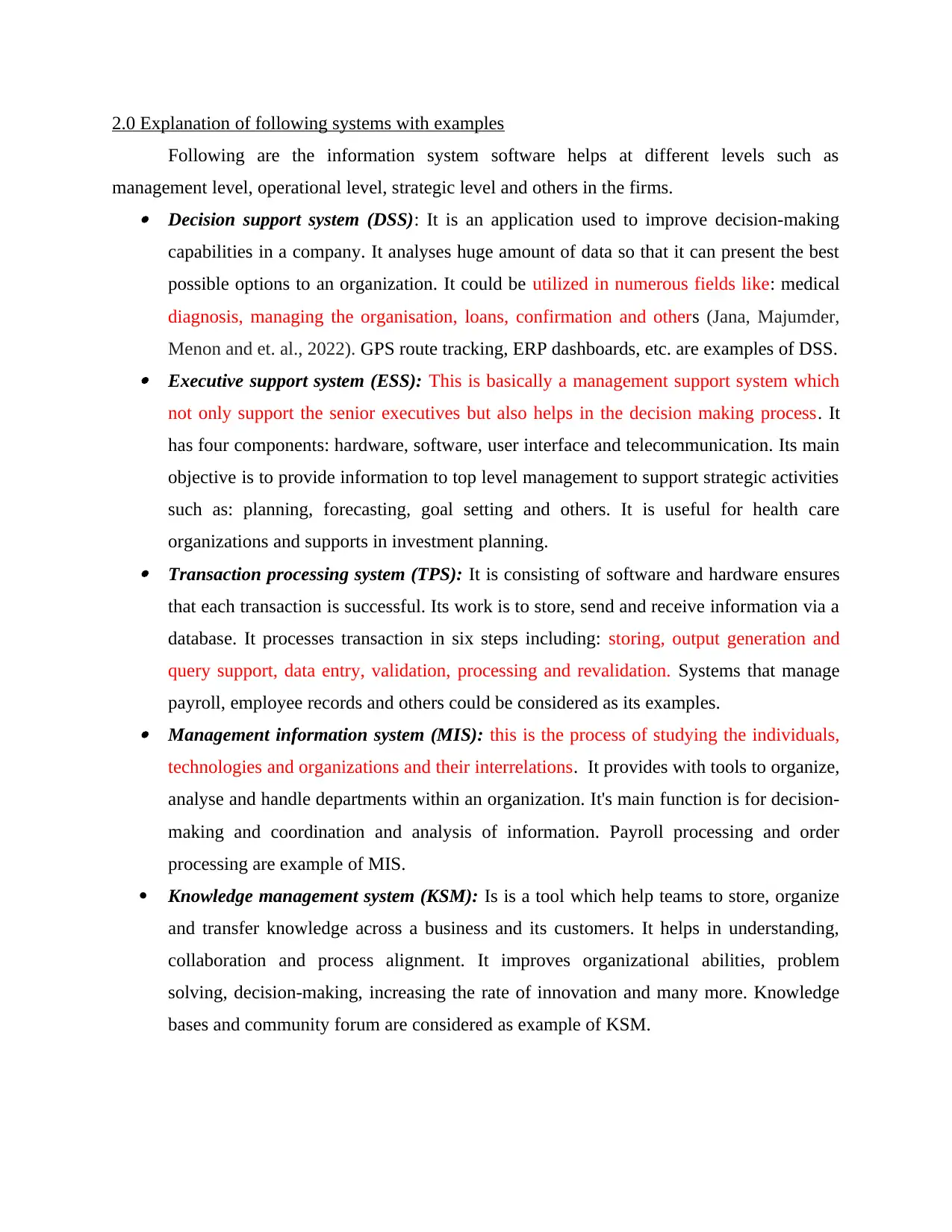
2.0 Explanation of following systems with examples
Following are the information system software helps at different levels such as
management level, operational level, strategic level and others in the firms. Decision support system (DSS): It is an application used to improve decision-making
capabilities in a company. It analyses huge amount of data so that it can present the best
possible options to an organization. It could be utilized in numerous fields like: medical
diagnosis, managing the organisation, loans, confirmation and others (Jana, Majumder,
Menon and et. al., 2022). GPS route tracking, ERP dashboards, etc. are examples of DSS. Executive support system (ESS): This is basically a management support system which
not only support the senior executives but also helps in the decision making process. It
has four components: hardware, software, user interface and telecommunication. Its main
objective is to provide information to top level management to support strategic activities
such as: planning, forecasting, goal setting and others. It is useful for health care
organizations and supports in investment planning. Transaction processing system (TPS): It is consisting of software and hardware ensures
that each transaction is successful. Its work is to store, send and receive information via a
database. It processes transaction in six steps including: storing, output generation and
query support, data entry, validation, processing and revalidation. Systems that manage
payroll, employee records and others could be considered as its examples. Management information system (MIS): this is the process of studying the individuals,
technologies and organizations and their interrelations. It provides with tools to organize,
analyse and handle departments within an organization. It's main function is for decision-
making and coordination and analysis of information. Payroll processing and order
processing are example of MIS.
Knowledge management system (KSM): Is is a tool which help teams to store, organize
and transfer knowledge across a business and its customers. It helps in understanding,
collaboration and process alignment. It improves organizational abilities, problem
solving, decision-making, increasing the rate of innovation and many more. Knowledge
bases and community forum are considered as example of KSM.
Following are the information system software helps at different levels such as
management level, operational level, strategic level and others in the firms. Decision support system (DSS): It is an application used to improve decision-making
capabilities in a company. It analyses huge amount of data so that it can present the best
possible options to an organization. It could be utilized in numerous fields like: medical
diagnosis, managing the organisation, loans, confirmation and others (Jana, Majumder,
Menon and et. al., 2022). GPS route tracking, ERP dashboards, etc. are examples of DSS. Executive support system (ESS): This is basically a management support system which
not only support the senior executives but also helps in the decision making process. It
has four components: hardware, software, user interface and telecommunication. Its main
objective is to provide information to top level management to support strategic activities
such as: planning, forecasting, goal setting and others. It is useful for health care
organizations and supports in investment planning. Transaction processing system (TPS): It is consisting of software and hardware ensures
that each transaction is successful. Its work is to store, send and receive information via a
database. It processes transaction in six steps including: storing, output generation and
query support, data entry, validation, processing and revalidation. Systems that manage
payroll, employee records and others could be considered as its examples. Management information system (MIS): this is the process of studying the individuals,
technologies and organizations and their interrelations. It provides with tools to organize,
analyse and handle departments within an organization. It's main function is for decision-
making and coordination and analysis of information. Payroll processing and order
processing are example of MIS.
Knowledge management system (KSM): Is is a tool which help teams to store, organize
and transfer knowledge across a business and its customers. It helps in understanding,
collaboration and process alignment. It improves organizational abilities, problem
solving, decision-making, increasing the rate of innovation and many more. Knowledge
bases and community forum are considered as example of KSM.
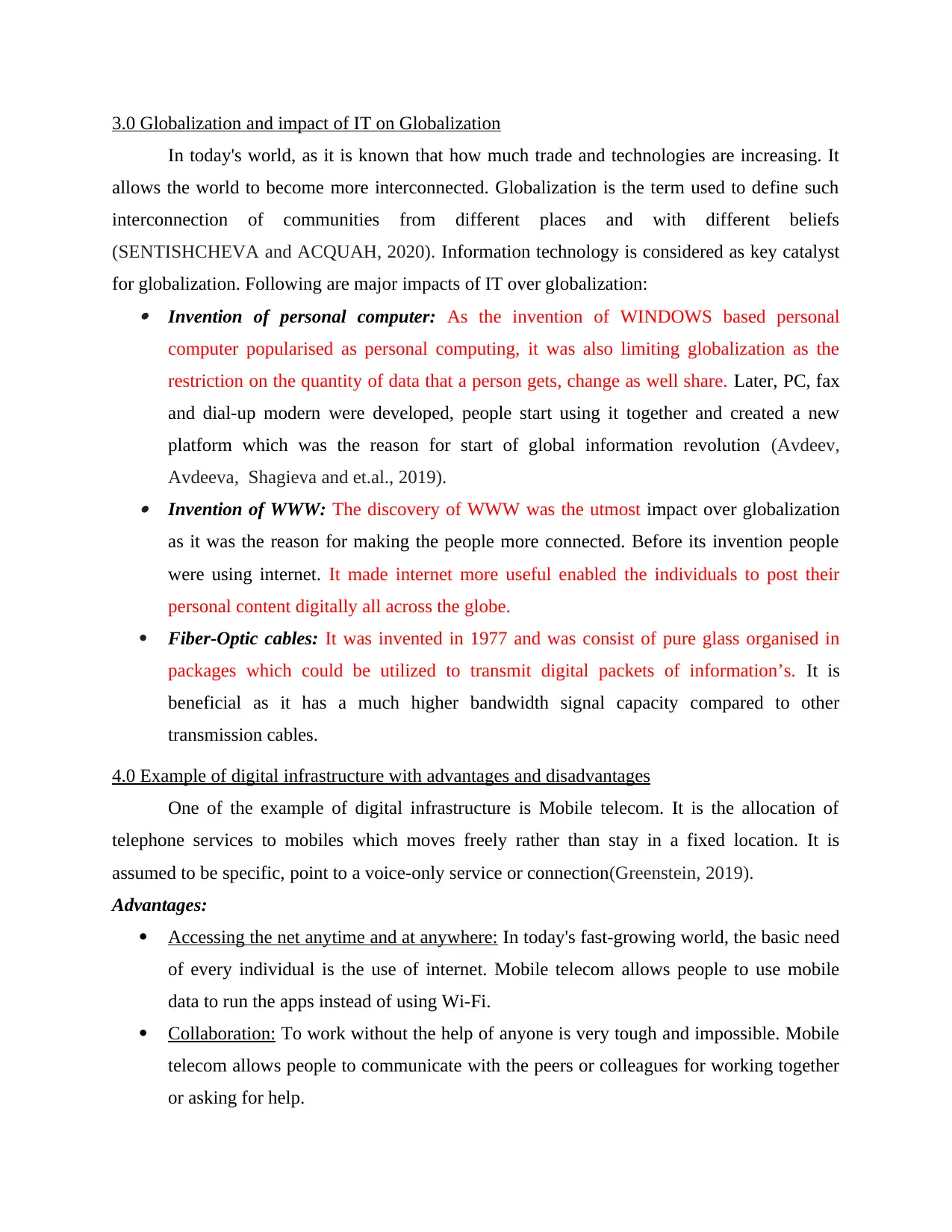
3.0 Globalization and impact of IT on Globalization
In today's world, as it is known that how much trade and technologies are increasing. It
allows the world to become more interconnected. Globalization is the term used to define such
interconnection of communities from different places and with different beliefs
(SENTISHCHEVA and ACQUAH, 2020). Information technology is considered as key catalyst
for globalization. Following are major impacts of IT over globalization: Invention of personal computer: As the invention of WINDOWS based personal
computer popularised as personal computing, it was also limiting globalization as the
restriction on the quantity of data that a person gets, change as well share. Later, PC, fax
and dial-up modern were developed, people start using it together and created a new
platform which was the reason for start of global information revolution (Avdeev,
Avdeeva, Shagieva and et.al., 2019). Invention of WWW: The discovery of WWW was the utmost impact over globalization
as it was the reason for making the people more connected. Before its invention people
were using internet. It made internet more useful enabled the individuals to post their
personal content digitally all across the globe.
Fiber-Optic cables: It was invented in 1977 and was consist of pure glass organised in
packages which could be utilized to transmit digital packets of information’s. It is
beneficial as it has a much higher bandwidth signal capacity compared to other
transmission cables.
4.0 Example of digital infrastructure with advantages and disadvantages
One of the example of digital infrastructure is Mobile telecom. It is the allocation of
telephone services to mobiles which moves freely rather than stay in a fixed location. It is
assumed to be specific, point to a voice-only service or connection(Greenstein, 2019).
Advantages:
Accessing the net anytime and at anywhere: In today's fast-growing world, the basic need
of every individual is the use of internet. Mobile telecom allows people to use mobile
data to run the apps instead of using Wi-Fi.
Collaboration: To work without the help of anyone is very tough and impossible. Mobile
telecom allows people to communicate with the peers or colleagues for working together
or asking for help.
In today's world, as it is known that how much trade and technologies are increasing. It
allows the world to become more interconnected. Globalization is the term used to define such
interconnection of communities from different places and with different beliefs
(SENTISHCHEVA and ACQUAH, 2020). Information technology is considered as key catalyst
for globalization. Following are major impacts of IT over globalization: Invention of personal computer: As the invention of WINDOWS based personal
computer popularised as personal computing, it was also limiting globalization as the
restriction on the quantity of data that a person gets, change as well share. Later, PC, fax
and dial-up modern were developed, people start using it together and created a new
platform which was the reason for start of global information revolution (Avdeev,
Avdeeva, Shagieva and et.al., 2019). Invention of WWW: The discovery of WWW was the utmost impact over globalization
as it was the reason for making the people more connected. Before its invention people
were using internet. It made internet more useful enabled the individuals to post their
personal content digitally all across the globe.
Fiber-Optic cables: It was invented in 1977 and was consist of pure glass organised in
packages which could be utilized to transmit digital packets of information’s. It is
beneficial as it has a much higher bandwidth signal capacity compared to other
transmission cables.
4.0 Example of digital infrastructure with advantages and disadvantages
One of the example of digital infrastructure is Mobile telecom. It is the allocation of
telephone services to mobiles which moves freely rather than stay in a fixed location. It is
assumed to be specific, point to a voice-only service or connection(Greenstein, 2019).
Advantages:
Accessing the net anytime and at anywhere: In today's fast-growing world, the basic need
of every individual is the use of internet. Mobile telecom allows people to use mobile
data to run the apps instead of using Wi-Fi.
Collaboration: To work without the help of anyone is very tough and impossible. Mobile
telecom allows people to communicate with the peers or colleagues for working together
or asking for help.

Time management: With the help of internet, the speed and efficiency of work is
increased and hence, it give benefit to the people to complete their work on time and it is
only become possible with the invention of telecom.
Disadvantages
Disrupt in work: As the use of internet and mobile is increasing rapidly, the use of mobile
phones are also increasing. It sometimes may cause disruption in work. As many people
become addict of using this technology and they are not able to focus at their work.
Lack of time: With the excess use of the internet, people spent too much time using
mobile phones. It may result in the delay of their work and hence, they may take more
time to completer the work.
Dependency: Many of the company becomes dependent over mobile telecom to
communicate with the dealers and handle the clients. Without internet it is quite tough to
work and promote the company's products and services.
5.0 Another example of digital infrastructure with its advantages and disadvantages
Cloud services is another example for digital infrastructure. These are the services
delivered over internet to the companies and customers on their demand. These are easily
available and affordable. Dropbox, sales-force, etc. are considered as cloud services.
Advantages
Reducing IT costs: in order to reduce the cost, the company management utilized the
Cloud Computing services provider. This reduce their operating cost because: upgrading
in cost of system and reduction in energy consumption costs.
Business continuity: As cloud services provides safety to the stored data of the company
by backing it up and protect it a safe and secure location, it is beneficial for the continuity
of a business. Collaboration efficiency: Collaboration gives the business the ability to communicate and
share information at different locations. Cloud computing enables a company to record
and share data securely.
Disadvantages
Internet connectivity: As every data in Cloud Computing such as: document, image,
video and others are stored in cloud which only run with the connection of internet,
anyone who is accessing data will enable if he doesn't have a good network connection.
increased and hence, it give benefit to the people to complete their work on time and it is
only become possible with the invention of telecom.
Disadvantages
Disrupt in work: As the use of internet and mobile is increasing rapidly, the use of mobile
phones are also increasing. It sometimes may cause disruption in work. As many people
become addict of using this technology and they are not able to focus at their work.
Lack of time: With the excess use of the internet, people spent too much time using
mobile phones. It may result in the delay of their work and hence, they may take more
time to completer the work.
Dependency: Many of the company becomes dependent over mobile telecom to
communicate with the dealers and handle the clients. Without internet it is quite tough to
work and promote the company's products and services.
5.0 Another example of digital infrastructure with its advantages and disadvantages
Cloud services is another example for digital infrastructure. These are the services
delivered over internet to the companies and customers on their demand. These are easily
available and affordable. Dropbox, sales-force, etc. are considered as cloud services.
Advantages
Reducing IT costs: in order to reduce the cost, the company management utilized the
Cloud Computing services provider. This reduce their operating cost because: upgrading
in cost of system and reduction in energy consumption costs.
Business continuity: As cloud services provides safety to the stored data of the company
by backing it up and protect it a safe and secure location, it is beneficial for the continuity
of a business. Collaboration efficiency: Collaboration gives the business the ability to communicate and
share information at different locations. Cloud computing enables a company to record
and share data securely.
Disadvantages
Internet connectivity: As every data in Cloud Computing such as: document, image,
video and others are stored in cloud which only run with the connection of internet,
anyone who is accessing data will enable if he doesn't have a good network connection.
Paraphrase This Document
Need a fresh take? Get an instant paraphrase of this document with our AI Paraphraser
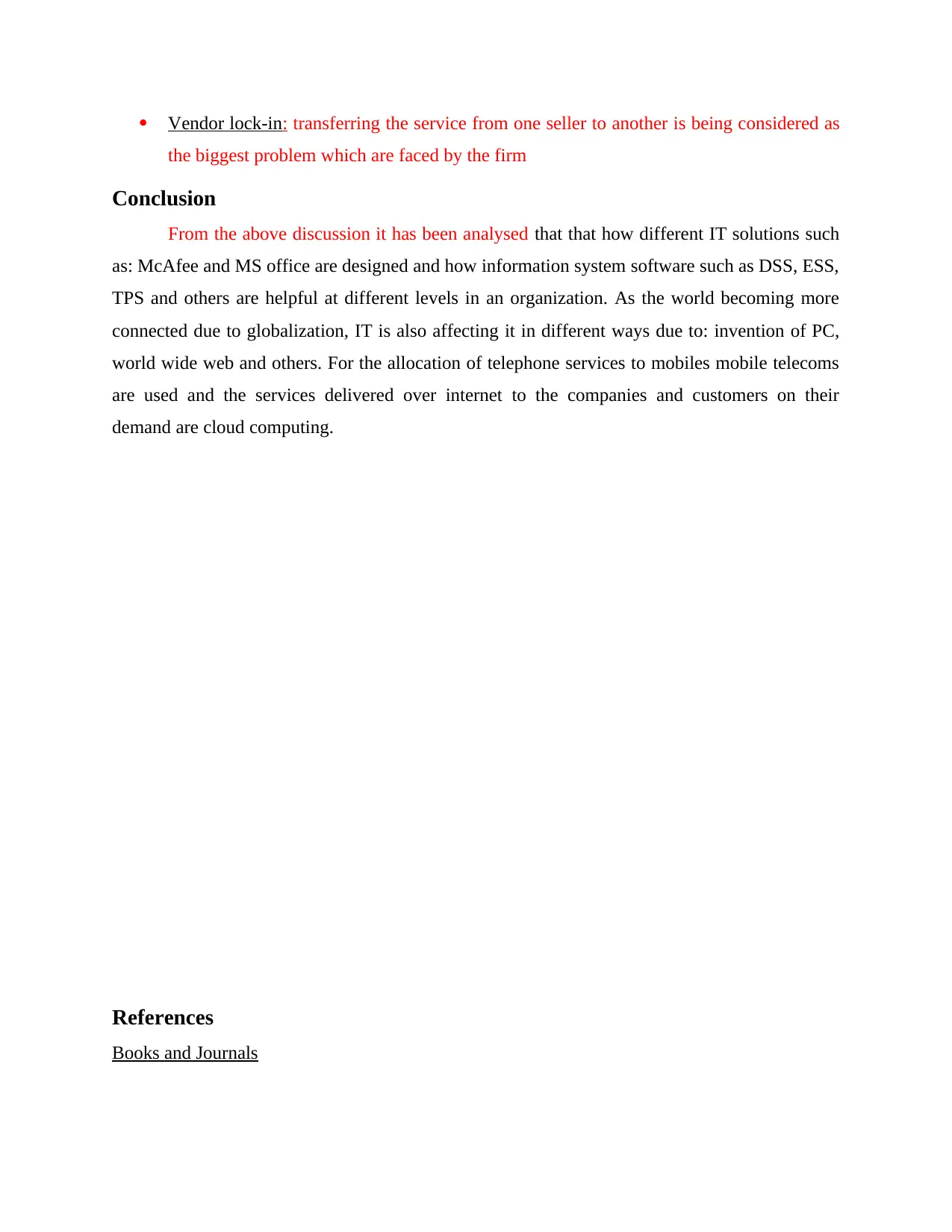
Vendor lock-in: transferring the service from one seller to another is being considered as
the biggest problem which are faced by the firm
Conclusion
From the above discussion it has been analysed that that how different IT solutions such
as: McAfee and MS office are designed and how information system software such as DSS, ESS,
TPS and others are helpful at different levels in an organization. As the world becoming more
connected due to globalization, IT is also affecting it in different ways due to: invention of PC,
world wide web and others. For the allocation of telephone services to mobiles mobile telecoms
are used and the services delivered over internet to the companies and customers on their
demand are cloud computing.
References
Books and Journals
the biggest problem which are faced by the firm
Conclusion
From the above discussion it has been analysed that that how different IT solutions such
as: McAfee and MS office are designed and how information system software such as DSS, ESS,
TPS and others are helpful at different levels in an organization. As the world becoming more
connected due to globalization, IT is also affecting it in different ways due to: invention of PC,
world wide web and others. For the allocation of telephone services to mobiles mobile telecoms
are used and the services delivered over internet to the companies and customers on their
demand are cloud computing.
References
Books and Journals
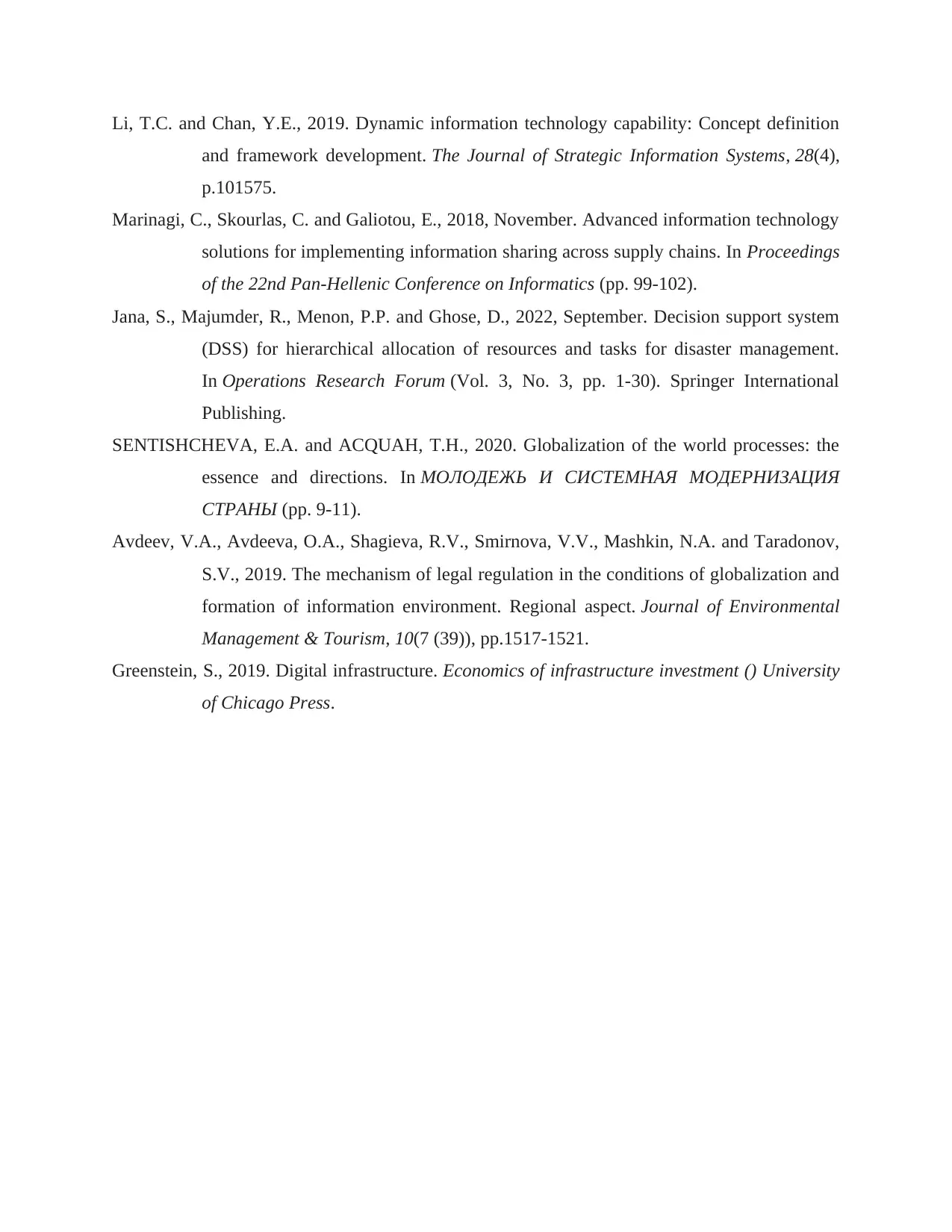
Li, T.C. and Chan, Y.E., 2019. Dynamic information technology capability: Concept definition
and framework development. The Journal of Strategic Information Systems, 28(4),
p.101575.
Marinagi, C., Skourlas, C. and Galiotou, E., 2018, November. Advanced information technology
solutions for implementing information sharing across supply chains. In Proceedings
of the 22nd Pan-Hellenic Conference on Informatics (pp. 99-102).
Jana, S., Majumder, R., Menon, P.P. and Ghose, D., 2022, September. Decision support system
(DSS) for hierarchical allocation of resources and tasks for disaster management.
In Operations Research Forum (Vol. 3, No. 3, pp. 1-30). Springer International
Publishing.
SENTISHCHEVA, E.A. and ACQUAH, T.H., 2020. Globalization of the world processes: the
essence and directions. In МОЛОДЕЖЬ И СИСТЕМНАЯ МОДЕРНИЗАЦИЯ
СТРАНЫ (pp. 9-11).
Avdeev, V.A., Avdeeva, O.A., Shagieva, R.V., Smirnova, V.V., Mashkin, N.A. and Taradonov,
S.V., 2019. The mechanism of legal regulation in the conditions of globalization and
formation of information environment. Regional aspect. Journal of Environmental
Management & Tourism, 10(7 (39)), pp.1517-1521.
Greenstein, S., 2019. Digital infrastructure. Economics of infrastructure investment () University
of Chicago Press.
and framework development. The Journal of Strategic Information Systems, 28(4),
p.101575.
Marinagi, C., Skourlas, C. and Galiotou, E., 2018, November. Advanced information technology
solutions for implementing information sharing across supply chains. In Proceedings
of the 22nd Pan-Hellenic Conference on Informatics (pp. 99-102).
Jana, S., Majumder, R., Menon, P.P. and Ghose, D., 2022, September. Decision support system
(DSS) for hierarchical allocation of resources and tasks for disaster management.
In Operations Research Forum (Vol. 3, No. 3, pp. 1-30). Springer International
Publishing.
SENTISHCHEVA, E.A. and ACQUAH, T.H., 2020. Globalization of the world processes: the
essence and directions. In МОЛОДЕЖЬ И СИСТЕМНАЯ МОДЕРНИЗАЦИЯ
СТРАНЫ (pp. 9-11).
Avdeev, V.A., Avdeeva, O.A., Shagieva, R.V., Smirnova, V.V., Mashkin, N.A. and Taradonov,
S.V., 2019. The mechanism of legal regulation in the conditions of globalization and
formation of information environment. Regional aspect. Journal of Environmental
Management & Tourism, 10(7 (39)), pp.1517-1521.
Greenstein, S., 2019. Digital infrastructure. Economics of infrastructure investment () University
of Chicago Press.
1 out of 9
Related Documents
Your All-in-One AI-Powered Toolkit for Academic Success.
+13062052269
info@desklib.com
Available 24*7 on WhatsApp / Email
![[object Object]](/_next/static/media/star-bottom.7253800d.svg)
Unlock your academic potential
© 2024 | Zucol Services PVT LTD | All rights reserved.
